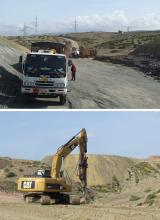Morocco’s Casablanca-Rabat motorway accounts for almost 20% of motorway tolls in the country, generating US$25.16 million for Autoroutes du Maroc (ADM) in the first half of 2014, a growth of 4.1% from the previous year. With relatively low maintenance costs (mainly used for widening the road) the Casablanca-Rabat motorway is ADM's most profitable route. The 76km route is travelled by 51,000 vehicles/day, far higher than any other motorway. The Berrechid-Agadir motorway (which includes Berrechid-Marrakesh an
Morocoo’s Casablanca-Rabat motorway accounts for close to 20% of toll revenue for the country’s tolled network
Morocco’s Casablanca-Rabat motorway accounts for almost 20% of motorway tolls in the country, generating US$25.16 million for 5199 Autoroutes du Maroc (ADM) in the first half of 2014, a growth of 4.1% from the previous year. With relatively low maintenance costs (mainly used for widening the road) the Casablanca-Rabat motorway is ADM's most profitable route. The 76km route is travelled by 51,000 vehicles/day, far higher than any other motorway. The Berrechid-Agadir motorway (which includes Berrechid-Marrakesh and Marrakesh-Agadir) is the only route with higher revenues. A 3% rise in traffic to 16.8 million vehicles/day during the first half of 2014 has meant that ADM has benefited from a 2.3% rise in turnover from the figure for 2013 to $85.4 billion. The improved roads and new motorway connections as well as tougher enforcement measures meanwhile have also helped lower crash statistics, with serious injuries dropping 21% and deaths falling 14.5% over the previous year.
In capital Casablanca construction work on 55km of roads is now underway. The work focusses on upgrades to the Errahma-Dar Bouâazza-Ouled Azzouz main roads and will cost some US$45.7 million. This will be handled under the PPP model. The work will see extensions put in place for a 17km section of the 320 motorway between Hay Hassani and Berrechid and a 2.3km stretch of the 3014 provincial road between Hay Hassani and Errahma cemetery. It will also see work to an 8.6km section of the Errahma cemetery and the 3001 provincial road and an 11.3km stretch of the n1 motorway between Lissasfa and Berrechid. Alongside this, the 3003 road between the n1 motorway and 320 regional road will be extended by 6km, while a 4.5km route between Hay Hassani and the 3003 provincial road will be constructed. In addition, a 4.8km stretch of the 3018 provincial route between the 3003 provincial road and Hay Hassani will be reworked.
Meanwhile the International Bank for Reconstruction and Development (IBRD) and the Moroccan Government have signed an agreement for a loan worth just over US$89 million to finance the second part of the country’s rural road scheme. And the Rabat bypass motorway is some 30% complete after three years of work and is set to open in 2016. Certain parts of the project, such as the large cable-stayed bridge in Oued Bouregreg, are more than 50% complete.
In capital Casablanca construction work on 55km of roads is now underway. The work focusses on upgrades to the Errahma-Dar Bouâazza-Ouled Azzouz main roads and will cost some US$45.7 million. This will be handled under the PPP model. The work will see extensions put in place for a 17km section of the 320 motorway between Hay Hassani and Berrechid and a 2.3km stretch of the 3014 provincial road between Hay Hassani and Errahma cemetery. It will also see work to an 8.6km section of the Errahma cemetery and the 3001 provincial road and an 11.3km stretch of the n1 motorway between Lissasfa and Berrechid. Alongside this, the 3003 road between the n1 motorway and 320 regional road will be extended by 6km, while a 4.5km route between Hay Hassani and the 3003 provincial road will be constructed. In addition, a 4.8km stretch of the 3018 provincial route between the 3003 provincial road and Hay Hassani will be reworked.
Meanwhile the International Bank for Reconstruction and Development (IBRD) and the Moroccan Government have signed an agreement for a loan worth just over US$89 million to finance the second part of the country’s rural road scheme. And the Rabat bypass motorway is some 30% complete after three years of work and is set to open in 2016. Certain parts of the project, such as the large cable-stayed bridge in Oued Bouregreg, are more than 50% complete.





